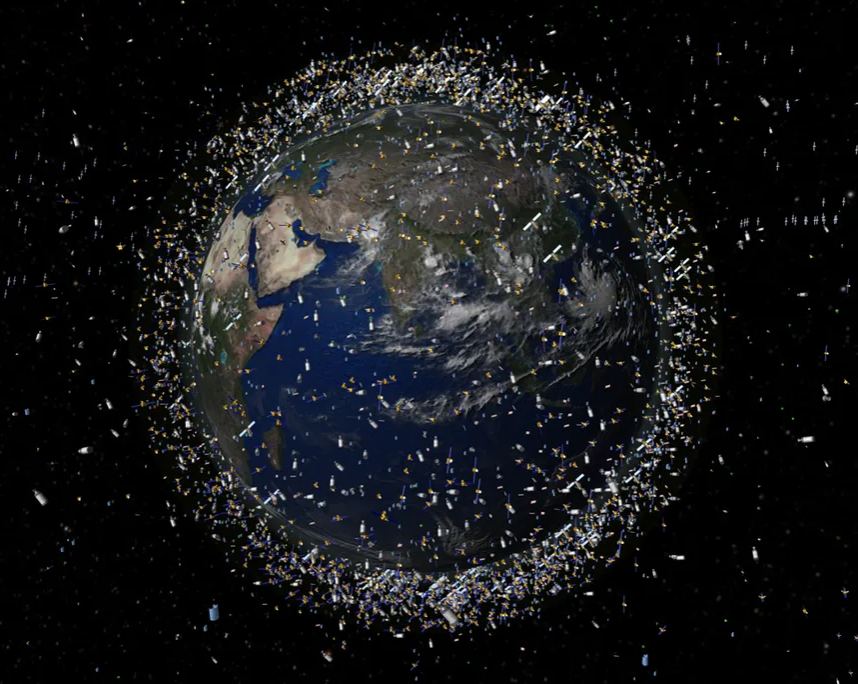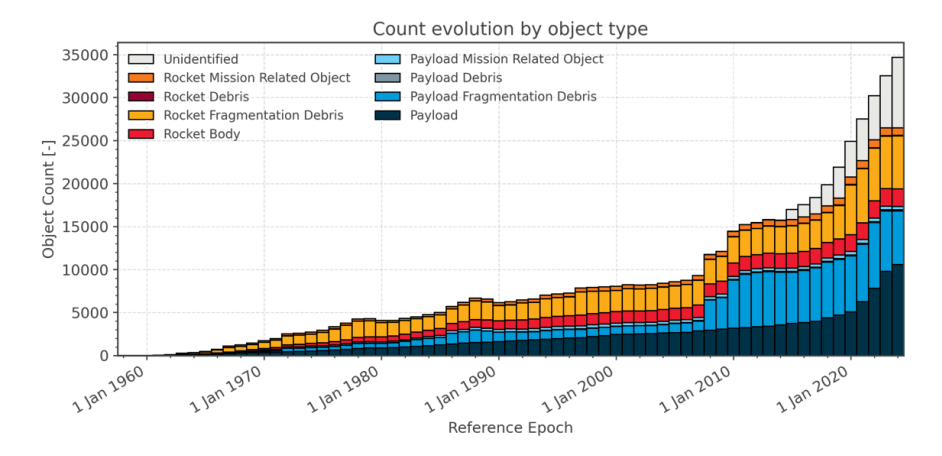What can we do about space junk? We know how much debris is in orbit, and we know the problem is getting worse. It's our fault.
Our Earth now has a halo of orbital debris, and the ESA has a plan to stop contributing to the problem.
You can only kick a can down a road for so long before you're tripping over all the cans. While politicians seem particularly adept at kicking them into the future and then blaming the other side when we're ankle-deep in pesky cans, people in scientific pursuits don't have the same luxury of intellectual dishonesty.
"Behaviours in space have to change."-ESA
We're all aware of the space debris problem, and we know it's getting worse. We've been launching satellites at an increased pace in the last few years. When combined with all of the satellites launched in prior decades, the result is a congested area that's getting more crowded by the month. And like empty cans kicked into the future, many of the objects in orbit are no longer functioning or serving any purpose. They're just there. If only someone had seen this coming.
But at least the ESA is committing to a plan to stop putting more debris in space.
"130 million pieces of space debris larger than a millimetre orbit Earth, threatening satellites now and in the future," the ESA writes. "Once a week, a satellite or rocket body reenters uncontrolled through our atmosphere. Behaviours in space have to change."
There's not much of an argument that things need to change. But in an international world where not all countries want to cooperate and where private companies are responsible for a growing amount of stuff in space, change is tricky.
The ESA is setting a new standard for itself. They call it the "Zero Debris Approach."
The space debris problem isn't something that exists down the road. In 2009, two satellites collided over Siberia. One was defunct, but one was active. Besides destroying an active Iridium satellite, the collision created a whole bunch more debris. Perhaps the most troubling part is that the collision was predicted. In fact, of all the satellites that come close to each other, these two weren't even in the top 200 satellites in dangerous proximity to one another.
"Arguably, the best approach is adopting practices that prevent creating debris in the first place," an article in American Scientist said at the time.
There's also the growing risk that even without any additional launches, collisions between existing debris will still make the problem worse. "It has been estimated that even in the case of no further launches into orbit, collisions among the existing space objects can lead to further growth in space debris population," the ESA writes. The worst possible outcome is the Kessler syndrome, where collisions produce more debris that leads to a growing cascade of collisions that ultimately makes Earth orbit unusable.
American astrophysicist Donald Kessler predicted the Kessler syndrome back in 1978. In 2012, he co-authored an article saying that we're already passed the tipping point for orbital debris. "That runaway debris generation scenario, often called the Kessler syndrome, may seem far off," the article said. "But in fact, the sheer density of derelict objects in orbit has already exceeded what many consider to be the mathematical point of no return."
There's lots of talk about developing systems to remove existing space debris, especially larger pieces like intact satellites. There's talk of harpoons, robotic arms, and even using other satellites to move debris into graveyard orbits. But there's not much action to stop adding more debris.
Now, here we are, almost 15 years since the collision, and at least the ESA got the message.
"We are seeing a dramatically increased use of space, but still insufficient technology to prevent the risks that follow. Our aim to become debris neutral in just a few years will require clearing precious Earth orbits once a mission is complete, and if the mission fails to do this, it must be actively removed by dedicated vehicles," explains Holger Krag, ESA's Head of Space Safety.
Krag likens it to the backcountry hiker's motto: pack out what you pack in. "We are aiming for rules that compare to every national park on Earth – what you bring in, you must take with you when you leave."
The ESA's Zero Debris Approach starts with mission design. In 2022, the ESA undertook a large study involving all of their sites across Europe as well as 270 experts from industry, governmental agencies and academia. The study produced recommendations to help the ESA reach Zero Debris by 2030. The recommendations form the basis of the recently published 'ESA Space Debris Mitigation Requirements.'
Here are the eight recommendations in the document:
- Guarantee successful disposal
- Improve orbital clearance
- Avoid in-orbit collisions
- Avoid internal break-ups
- Prevent the intentional release of space debris
- Improve on-ground casualty risk assessment
- Guarantee Dark and Quiet skies
- Beyond the protected regions (This includes GNSS
That's a pretty comprehensive list, and it should be. We rely heavily on satellites, but many of us never think about them. They're an important structural element in modern society.
"As space infrastructure has become the backbone of our modern society, the proliferation of space debris is threatening our way of life. Now is the time to act as a community to channel our collective efforts," said ESA Director General Josef Aschbacher. "To implement the Zero Debris Charter, ESA will focus on developing ground-breaking technologies for satellite end-of-life disposal, in-orbit servicing and active debris removal. In addition, ESA will work hand-in-hand with institutions in charge of regulatory aspects."
So, where are the rest of the world's space agencies on this issue? NASA has made lots of statements about 'limiting' orbital debris and even has an office dedicated to the problem. But they haven't taken the same type of bold step the ESA has.
China? They're working on ways to de-orbit space junk successfully. But again, no bold, clear language commitment. ISRO? India's set up a Centre for Space Debris Research, but they've made no promises about not adding to the problem.
How about Russia? Does what's left of Roscosmos' corpse have any plans? They make all kinds of statements, but nobody believes them. Especially since they keep messing with everyone else's satellites.
You've gotta hand it to the ESA. Even though they're an organization made up of 22 separate nations, they've come together and are the ones leading the charge on this issue.
Now, it's up to others to follow.
 Universe Today
Universe Today


